|
SEPTEMBER 2020
|
|
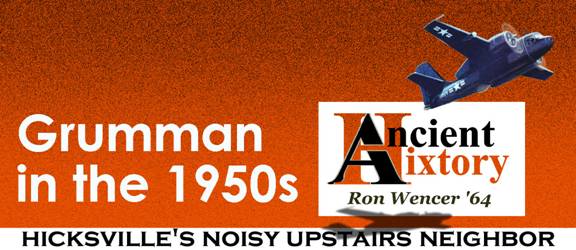
|
|
Introduction
|
Many of us who grew up in
Hicksville
during the 1950s got used to hearing loud, sometimes
conversation-stopping, airplanes pass overhead.
Prior issues of Ancient
Hixtory put some of these noisy interruptions into historical
context, by discussing the respective roles that Mitchel Field and
Republic Aviation played as America in turn faced the demands of World
War II, of Korea, of Vietnam, and ultimately, of aerospace.
If you wish, the links below will take you to those articles:
This third article offers a glimpse of
Grumman Aircraft. That
glimpse is of necessity incomplete, for the company's story is
extensive, and continues today through Northrop-Grumman.
It concerns itself only with the Grumman aircraft I knew best as
a child in Hicksville - those which regularly left Bethpage and banked
ever so low, over
Lee
Avenue
School
, and over my home on
7th Street
.
|
***
|
|
A
Too-Brief History of Grumman
|
Beginnings
Late
in 1929,
America
's aircraft industry was young, improvisational, and - given the
recent crash of the stock market - uncertain.
Much of the industry was moving to the central
Long Island
plains, which had not yet erupted into suburbs.
Blessed with a "we can do it" attitude, several young men
joined together to form a new company, which would be led by Leroy
Grumman. As a new aviation
company, it needed income to survive "until the business took off"
(so to speak). At first,
while it pondered how to make its mark, the company sustained itself by
doing specialized work for other companies, such as welding aluminum
tubing.
Grumman soon found a way to make that mark.
In an era in which airplanes could land only on water, or only on
land, it built airplane floats with retractable wheeled landing gear.
For the first time, an airplane could be based either on land or
on water. For that matter,
if landing gear that retracted would work for float planes, it would
work for land planes, too. Grumman
built the first biplane with retractable landing gear.
Suddenly, land-based airplanes could fly a little faster (because
of reduced drag) and a little further (with less drag, they burned less
fuel per mile).
World War II
Grumman's airplanes rapidly began earning the company respect,
particularly with regard to the U.S. Navy.
Continuing to innovate as the 1930s progressed, the company
demonstrated exceptional prowess with fold-and-stow wing designs, and it
earned a presence on the flight decks of
America
's aircraft carriers. Grumman
Wildcats, Hellcats, and Avengers
would eventually be at the core of
America
's naval airpower in the Pacific Theatre during World War II.
|
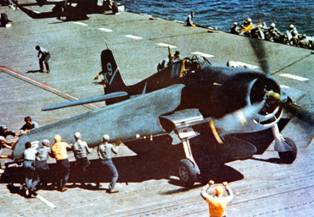
|
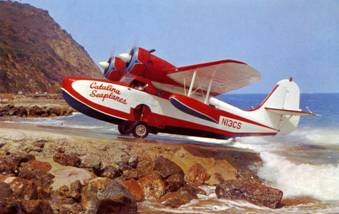
|
|
Deploying
folded wings before flight:
a Hellcat aboard USS Yorktown
Wikimedia
Commons; Ray Wagner Collection
|
Grumman
Goose at Santa Catalina
Tom Wigley photograph
https://www.flickr.com/photos/amphalon/8428551579
|
The
company also penetrated the civilian market, making amphibious aircraft
that floated on their hulls. One
of these, the Goose, was a
dual milestone for Grumman - its first monoplane, and also its first
multi-engine aircraft. Built
for commuting and small coastal airlines, it also saw service as a light
military transport.
Post-War Years
As the Cold War set in, Grumman's markets multiplied:
|
▪
|
It
continued to develop and build front-line naval fighting
aircraft.
|
|
▪
|
It
developed and built the Navy's first purpose-made
anti-submarine aircraft.
|
|
▪
|
It
developed and built the Navy's first early-warning aircraft.
|
|
▪
|
It
developed and built the era's most successful amphibious
rescue aircraft.
|
|
▪
|
It
launched the Gulfstream
business air transport project.
|
|
▪
|
It
developed and built the Lunar
Excursion Module for NASA's Apollo
program.
|
|
*
|
Hicksville's Skies in the 1950s
Around 1950, the bulk of Grumman's manufacturing work migrated to
Calverton, which left the runways at the Bethpage headquarters more
quiet - but they were not completely silent.
In the years that followed, there were numerous flights of
private (i.e., business) aircraft, as Grumman executives and engineers
met constantly with clients, project partners, and government officials.
R&D work on existing aircraft sometimes continued.
Now and then, one heard the urgent shriek of a Cougar or Tiger fighter as
it climbed out of Bethpage.
During this time, aircraft of two types dominated Grumman's air
traffic over Hicksville: anti-submarine
and amphibious rescue.
|
***
|
|
Anti-Submarine
Warfare (ASW)
|
Not
Your Mother's Submarine
In World War II, submarines accomplished tactical jobs - attacking
military vessels, interfering with supply shipping, surreptitiously
transporting agents, even surfacing near shore to strafe targets.
By 1950, however, people realized that the next generation of
subs would be used more strategically.
Someday, a submerged nuclear submarine might remain untraceable
for months, and then launch a missile attack on an inland target.
This was not some hypothetical notion - the U.S. was about to
construct the first nuclear submarine, and within five years, the Soviet
Union would effect the first underwater launch of a missile.
Obviously, the ability to detect and disable enemy submarines was
becoming critically important.
First Steps
Up to that time, locating and sinking
enemy subs was a slow process. It
usually involved sending multiple reconnaissance aircraft (often slow,
lumbering airplanes that could cover great distances without refueling)
on sub-hunting missions. If
one of them located a sub, it circled above it, reported its discovery,
and tried to mark the spot for the attack aircraft that would be
dispatched, usually from a distant location.
With luck, the sub would still be nearby when the attack plane(s)
arrived.
The Navy now redeployed some of its
existing aircraft into dedicated ASW
teams. A team consisted of a
Hellcat and an Avenger, both of the aircraft having been modified for their new
jobs. One served as a
"hunter," the other as a
"killer". The team
approach promised quicker action once a submarine was located.
As the Navy gained experience using teams, it learned a number of
things. The most significant
was that the amount of 1940s-sized electronics it had crammed into the
lean WW II combat planes was insufficient, for they were too small.
Larger airplanes, with more room for electronic equipment, were
needed.
Guardian
Meanwhile,
as demand for specialized ASW
aircraft grew, the Navy's requirements for some of its traditional
types of aircraft ebbed. Among
the several projects it canceled was one for a large carrier-based
torpedo bomber. Grumman
proposed that the spacious airframe it had been developing for the
now-discontinued bomber would work for an anti-sub aircraft, and that by
capitalizing on the work already done, development of a "pure" ASW
plane would be accelerated. The
Navy agreed, and the Guardian
program was born. Although Guardian would continue the two-airplane "hunter / killer"
approach, the capability of both aspects would be improved
substantially.
The first test flights of the resulting aircraft occurred in 1945, but Guardians
were not operational until late 1950.
Hicksville's quiet potato fields witnessed many low flights of
the new planes during these years of development.
|

|
|
Grumman
Guardians
"Hunter" (front) and "Killer" (rear)
Flight
Journal, flight.journal.com
|
The bulging aircraft in the foreground
above was stuffed with electronic surveillance equipment - and also
with some human operators, who coordinated the work of the two airplanes
in the team.
Incidentally, the airplane's size may not be apparent from this
photograph. When these
aircraft were introduced, they represented the largest single-engine
airframe ever to have flown from an aircraft carrier.
Tracker
The Guardian was a quickly
implemented improvement that adequately housed early stages of
electronic surveillance systems. The
Navy's experience with it soon led to a more powerful, longer-term
solution, one which would give the Navy the all-in-one ASW
weapon it desired. The new
aircraft was the twin-engined Grumman Tracker.
|

|
|
Grumman
two-page advertisement in National Geographic, April 1955
The
presence of a prominent advertisement for strategic weaponry in
a magazine like National Geographic was symptomatic of
America's
1950s fears. At any
time, the Cold War might suddenly turn very hot.
|
Although
the Calverton manufacturing site was operational by now, there still
would be continuous work to do at Bethpage while manufacturing
proceeded. The need for more
R&D into ASW seemed to
never stop. In consequence,
even as Trackers became operational, one or two always seemed to be around
Bethpage (and thus, over Hicksville) to test new ideas.
It was hard not to notice Trackers
- like many carrier-based aircraft, they were remarkably noisy things,
emitting a loud buzz of rapid, crisp, sharp sounds at take-off.
Many a window on 7th Street rattled when they flew
overhead.
Eventually, Trackers would be
used by a wide range of friendly forces, including those of Australia,
Turkey, the Netherlands, and Argentina.
One of the early foreign adopters was Japan, which under the
terms of the 1945 peace treaty had been limited with respect to
possessing military aircraft for its own purposes.
In 1957, it acquired several Trackers,
which were categorized as defensive aircraft.
I can remember the day when I first became aware of that.
My class at Lee Avenue was out in the large grassy yard behind
the school, and not for the first time, things suddenly got loud. The
school was directly in the path of traffic from the main Grumman runway,
and brief but intense aircraft noise was common (e.g., if classroom
windows were open, a teacher sometimes had to stop speaking until a
plane was gone). This time,
the noise was louder than usual. When
I looked up, I saw two Trackers
approaching in tight formation, one diagonally behind the other; they
must have taken off simultaneously.
What struck me instantly was neither the racket nor the tight
proximity of the aircraft, but their markings - they bore the large
red disks that signified Japan.
|
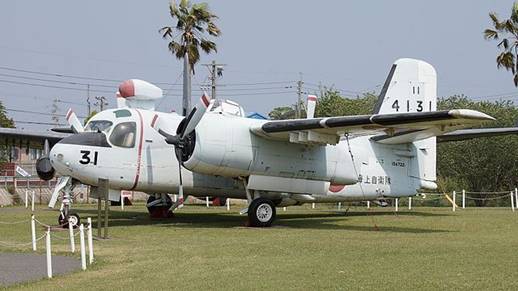
|
|
In
Japanese service, the Tracker was called "Aotaka," which
means
"Blue Hawk." Its
time in the Japan Air Self-Defense Force complete,
this unit is now displayed at Kanoya Air Base Museum.
Wikimedia
Commons, photographed/contributed by Hunini
|
Momentarily,
that insignia gave me pause. My
father, like the fathers of many of my fellow students, often watched Victory
at Sea and other post-war documentary television programs, and I
usually watched with him. To
now see Japanese aircraft approaching low over the schoolyard briefly
brought to mind black-and-white scenes of wartime attacks.
A quick look around showed me that no one else in the schoolyard had
looked up at the Trackers.
I watched them fly overhead harmlessly, shrugged, and went back
to whatever I'd been doing, but I never forgot that moment.
From
the 1930s, one of Grumman's traditional niches had been building
amphibious airplanes, which inevitably were named after water fowl.
Over the years, the amphibians had grown in size, from the
single-engined Duck to the
twin-engined Goose, through
the larger Widgeon, and then
to the still larger post-war Mallard.
The latter was something of a transitional aircraft - it had a
strong appeal for corporate and wealthy individual clients (e.g., the
Aga Khan bought one), but it did not penetrate the regional airline
market as deeply as Grumman had hoped.
Grumman proved nimble. It
quickly decided to extrapolate the Mallard's
design into a larger, higher capacity, longer-range version, initially
designated the Pelican, which
made its first test flight late in 1947:
Ironically,
enlarging the design did not help it penetrate the coastal airline
market - in the late 1940s, there were too many cheap war-surplus
transports available, and too many small airfields they could use.
Besides, other than at an amusement park, would you want to ride
in something called the Pelican?
On the other hand, the new aircraft was remarkably well suited for
rescue missions.
"At length did cross an Albatross,
Thorough the fog it came;
As if it had been a Christian soul,
We hailed it in God's name."
Samuel
Taylor Coleridge
The Rime of the Ancient Mariner
The
traditional superstition that albatrosses aided mariners in need led to
Grumman's renaming the new aircraft.
The name Albatross
stuck, for the aircraft was perfect for rescuing the survivors of
disasters at sea, as well as for providing relief to the populace of
storm-damaged islands. Introduced
to U.S. forces in 1949, it also was used by many foreign air services,
in some of which it served well into the 1990s.
|

|
|
Per
this advertisement, in 1955 the U.S. Air Force's
Rescue Squadrons around the world flew more than
3,000 missions, averaging about eight hours each, to
save nearly 2,000 people from death, and to deliver
relief supplies and medical aid to more than 20,000
disaster victims.
National
Geographic, May 1956
|
Like
other Grumman planes, the Albatross
was improved as the years went by, which resulted in continued test
flights out of Bethpage. The
most significant change was the development of a longer-range version,
with a 20% greater wingspan. In
order to maintain good flying characteristics, the tail-end control
surfaces were correspondingly enlarged as well.
Late in their USAF service, some Albatrosses were refitted for special
missions in Vietnam.
|
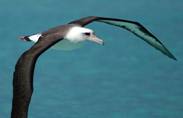
|

|
|
Non-Grumman
Albatross
Caleb
Slemmons photograph
Allaboutbirds.org
|
Restored,
privately-owned Grumman Albatross
tpaero.com
|
|
***
|
|
Beyond
Anti-Submarine Warfare
|
Within three years of the Tracker's
becoming operational in 1952, Grumman delivered (at the Navy's
request) a transport version of the Tracker,
called the Trader. Although the
versions looked alike at first glance, the new aircraft had a broader
body, and its greater interior space made it better suited for
transporting personnel or cargo.
|

|

|
|
not
a Tracker, but a Trader
National
Archives and Records Administration
|
Grumman
Tracer
U.S.
Navy National
Museum of Naval Aviation
|
Grumman was very busy indeed; another
spin-off followed a year later. The
larger airframe designed for the Trader
also became the basis of an early-warning aircraft, the Tracer. For obvious
reasons, the appearance of the Tracer
was distinctive. As I
recall, when one of them flew over Hicksville in those years, it usually
was accompanied at takeoff by a Trader
- unless it was it a Tracker -
the crew of which monitored the domed aircraft,
likely watching for aerodynamic problems or other flight issues.
The radar dome was, of course, something new for Grumman, and it had an
impact on Grumman tradition: it forced the company to revisit its
venerable Stow-Wing hinge
design. To avoid hitting the
dome, the Tracer's wings had
to fold backward, rather than upward as usual.
The Tracer served in Vietnam,
providing attack vectors for U.S. aircraft, and also alerting U.S.
forces to enemy interceptor activity.
It was finally withdrawn from service in 1977.
|
***
|
|
Leaving
the 1950s Behind
|
As the 1960s loomed, two new projects
were getting under way. Neither
would get off to a promising start.
One was the Mohawk, an
aircraft originally proposed in response to similar requests made by the
Army and the Marine Corps, both of which wanted multi-purpose
all-weather aircraft that could operate from small unimproved fields.
As the project tried to progress, it was impeded (and almost
scuttled) by decisions reached by the Navy and the Air Force - neither
of which had been directly involved when things started.
When the dust settled, it was determined that the Mohawk was to be built only for the Army.
It served well in a variety of roles in Vietnam, and also in Desert
Storm. After more than
three decades of service, it was retired in 1996.
|

|
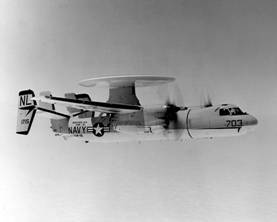
|
|
U.S.
Army Mohawk
Max
Haynes photograph
MaxAir2Air.com
|
E2A
Hawkeye
Wikipedia
Commons
|
The other project was the E2A
Hawkeye, a carrier-borne early warning aircraft meant to replace the
Tracer.
The project's early years struggled with two significant
issues: size and heat.
The Hawkeye was to be a
state-of-the-art aircraft that could be at home on Essex-class (i.e., World War II design) aircraft carriers.
Although not excessively old, these ships were small for
carriers, even by the standards of the day.
They had been upgraded, so that they could accommodate early jet
aircraft. The Navy - which
was already building larger new carriers - was not going to rebuild
them again. Having to make
the Hawkeye small enough to
fit on the old carriers meant that the mandated equipment inside the
airplane got crammed together, making the crew's work very difficult.
Things were made worse by the computers with which the Hawkeyes were first equipped. Beginning
in the late 1940s, the Navy had participated with private industry in
the development of "drum computers."
Unlike today's computers, which use memory chips for RAM, these
computers used rotating metal drums (i.e., cylinders, similar in concept
to those used for early phonographs, but which retained magnetic
charges). The computers
generated a great deal of heat, and in flight they often failed, due
either to the heat itself, or perhaps to the effect upon drum rotation
of the inevitable sudden movements of the aircraft.
These conditions rendered the E2A
unreliable at best. Ultimately,
they were addressed by withdrawing it from service, and rebuilding each E2A
into an E2B. Among the many
improvements introduced was replacing the drum computers with more
modern machines, likely ones which instead used more reliable magnetic
core memory, which had been gaining widespread acceptance for several
years. Unlike its
predecessor, the E2B worked
quite well.
At the time that the E2Bs were introduced, two aircraft were set aside for ongoing use as
test beds for the evaluation of future radar technology, which was
advancing quickly. Such
tests kept them flying over Hicksville for a long time.
This research effort led to the substantially more capable E2C Hawkeye of the 1970s, which could interact smoothly during
missions with the computers aboard friendly combat aircraft (e.g., Tomcats).
The research did not stop there; more recently it has produced
the E2D, which today plays a
key Navy role as an Airborne Warning and Control System (AWACS)
aircraft.
I find it incredible that the Hawkeye,
an aircraft which Grumman began designing in the late 1950s, has been
improved continuously for 60+ years, so that now, well into the
twenty-first century, it is still a crucial part of America's combat
forces. Leroy Grumman would
feel proud.
This month, the sources named in the
captions are all that I shall list specifically.
Over the years, I have read many other relevant books and
articles - too many to mention or remember - especially during the
latter 1970s, when we lived in Bethpage, adjacent to the head of the
Grumman runway that was used early every morning by Hawkeyes.
For those who are interested in reading more about Grumman, there
is ample material available online, in libraries, and in larger
bookstores.
As with people who serve in uniform,
after retirement from the military, a number of Trackers
and Traders continued to serve
in other ways. Many of them
began new careers as water bombers in Europe and in the Americas.
Although they could at best carry "only" about 1,200 gallons
at a time, the Grummans were agile fliers, and with good piloting they
were able to drop their loads more precisely than could many larger
aircraft.
I leave you with this recent picture of a Grumman Tracker in France, one of the few Tracker water bomber conversions still flying.
|
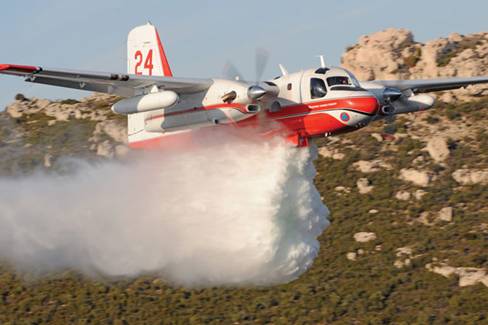
|
|
Turbo
Firecat of the SÚcuritÚ Civile, the civil defense arm
of the French Ministry of the Interior
This
aircraft is one of 35 water bombers built in the 1980s by
Conair Aviation from former Canadian and American Navy
Trackers, many of them upgraded with more modern engines.
The Turbo Firecats of the SÚcuritÚ Civile are expected to keep
fighting fires in France until they are retired in 2022.
skiesmag.com
Anthony Pecchi photograph
|
|
*****
|
|
Ciao!
|
|














